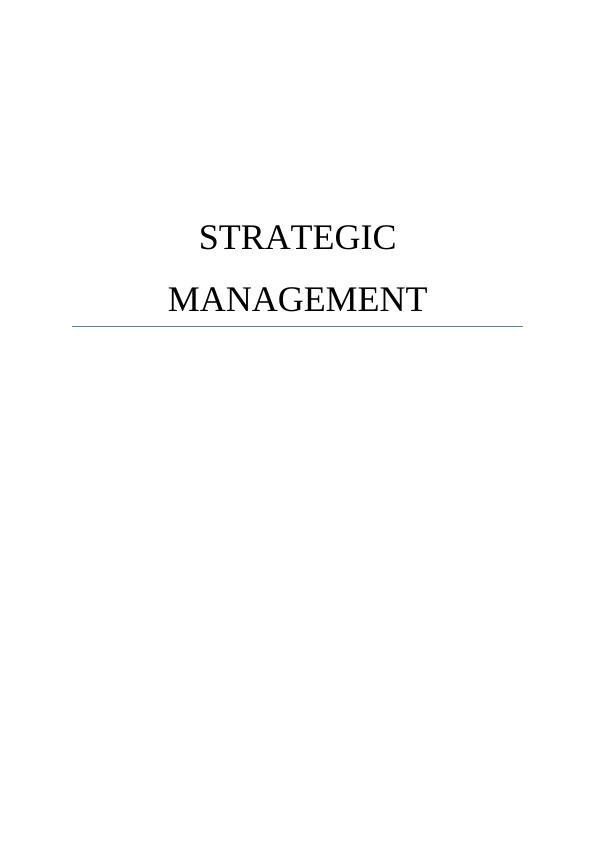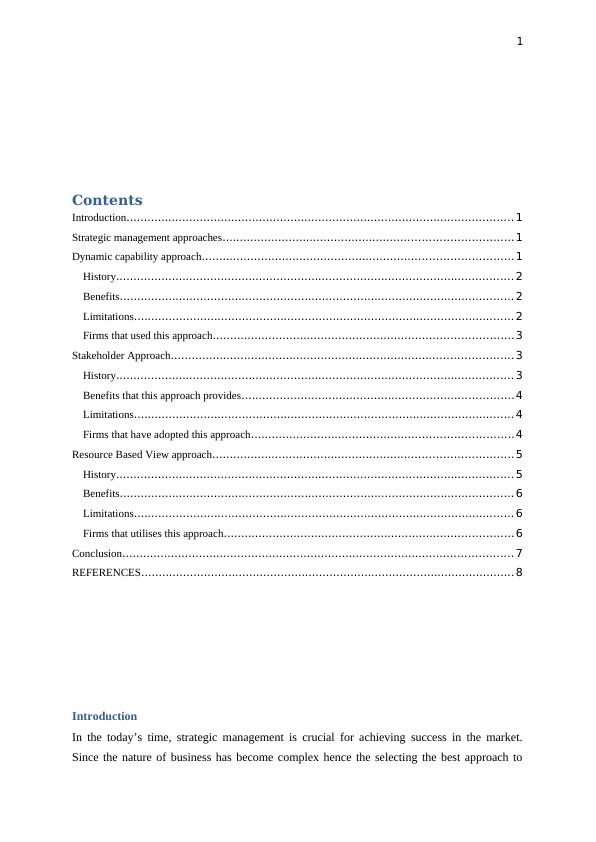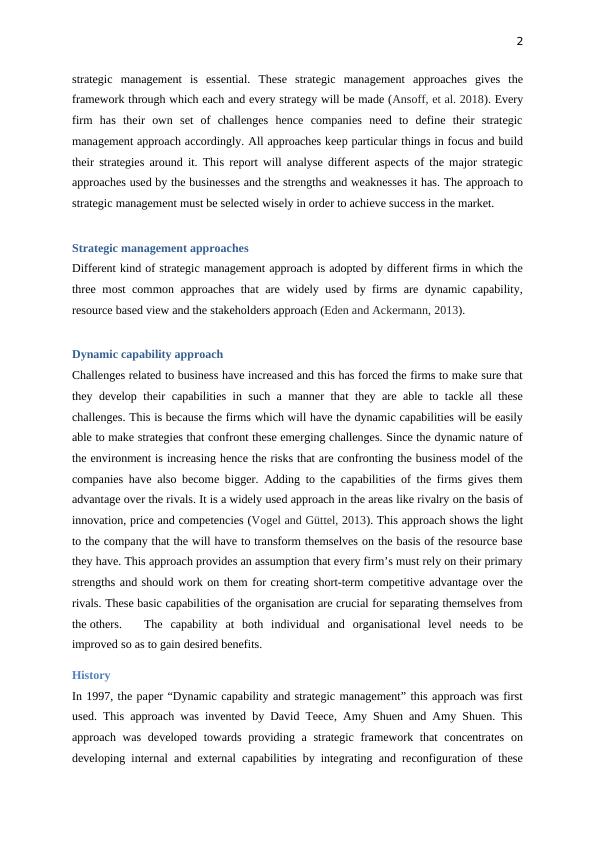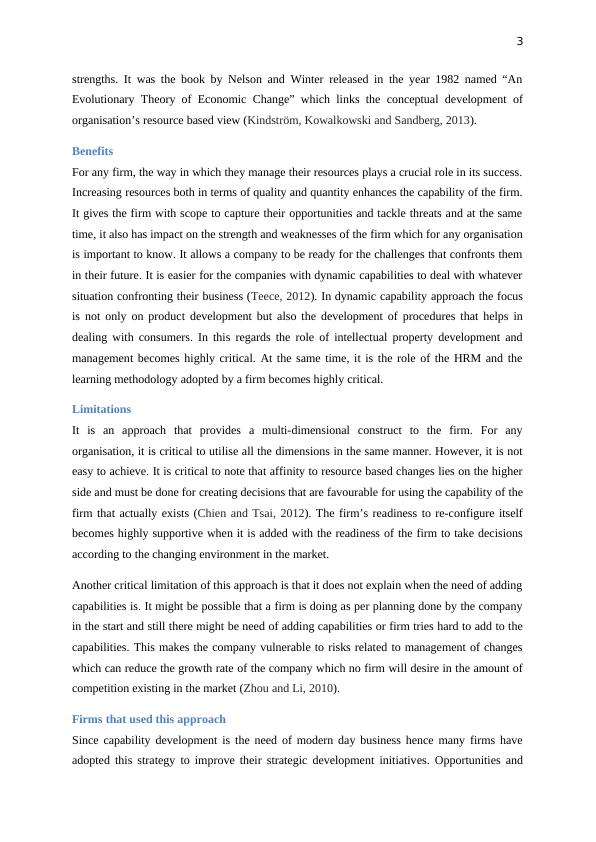Strategic Management Approaches: Dynamic Capability, Stakeholder, Resource Based View
Added on 2022-11-16
11 Pages3560 Words258 Views
STRATEGIC
MANAGEMENT
MANAGEMENT

1
Contents
Introduction............................................................................................................... 1
Strategic management approaches................................................................................... 1
Dynamic capability approach......................................................................................... 1
History.................................................................................................................. 2
Benefits................................................................................................................. 2
Limitations............................................................................................................. 2
Firms that used this approach...................................................................................... 3
Stakeholder Approach.................................................................................................. 3
History.................................................................................................................. 3
Benefits that this approach provides.............................................................................. 4
Limitations............................................................................................................. 4
Firms that have adopted this approach...........................................................................4
Resource Based View approach...................................................................................... 5
History.................................................................................................................. 5
Benefits................................................................................................................. 6
Limitations............................................................................................................. 6
Firms that utilises this approach................................................................................... 6
Conclusion................................................................................................................ 7
REFERENCES........................................................................................................... 8
Introduction
In the today’s time, strategic management is crucial for achieving success in the market.
Since the nature of business has become complex hence the selecting the best approach to
Contents
Introduction............................................................................................................... 1
Strategic management approaches................................................................................... 1
Dynamic capability approach......................................................................................... 1
History.................................................................................................................. 2
Benefits................................................................................................................. 2
Limitations............................................................................................................. 2
Firms that used this approach...................................................................................... 3
Stakeholder Approach.................................................................................................. 3
History.................................................................................................................. 3
Benefits that this approach provides.............................................................................. 4
Limitations............................................................................................................. 4
Firms that have adopted this approach...........................................................................4
Resource Based View approach...................................................................................... 5
History.................................................................................................................. 5
Benefits................................................................................................................. 6
Limitations............................................................................................................. 6
Firms that utilises this approach................................................................................... 6
Conclusion................................................................................................................ 7
REFERENCES........................................................................................................... 8
Introduction
In the today’s time, strategic management is crucial for achieving success in the market.
Since the nature of business has become complex hence the selecting the best approach to

2
strategic management is essential. These strategic management approaches gives the
framework through which each and every strategy will be made (Ansoff, et al. 2018). Every
firm has their own set of challenges hence companies need to define their strategic
management approach accordingly. All approaches keep particular things in focus and build
their strategies around it. This report will analyse different aspects of the major strategic
approaches used by the businesses and the strengths and weaknesses it has. The approach to
strategic management must be selected wisely in order to achieve success in the market.
Strategic management approaches
Different kind of strategic management approach is adopted by different firms in which the
three most common approaches that are widely used by firms are dynamic capability,
resource based view and the stakeholders approach (Eden and Ackermann, 2013).
Dynamic capability approach
Challenges related to business have increased and this has forced the firms to make sure that
they develop their capabilities in such a manner that they are able to tackle all these
challenges. This is because the firms which will have the dynamic capabilities will be easily
able to make strategies that confront these emerging challenges. Since the dynamic nature of
the environment is increasing hence the risks that are confronting the business model of the
companies have also become bigger. Adding to the capabilities of the firms gives them
advantage over the rivals. It is a widely used approach in the areas like rivalry on the basis of
innovation, price and competencies (Vogel and Güttel, 2013). This approach shows the light
to the company that the will have to transform themselves on the basis of the resource base
they have. This approach provides an assumption that every firm’s must rely on their primary
strengths and should work on them for creating short-term competitive advantage over the
rivals. These basic capabilities of the organisation are crucial for separating themselves from
the others. The capability at both individual and organisational level needs to be
improved so as to gain desired benefits.
History
In 1997, the paper “Dynamic capability and strategic management” this approach was first
used. This approach was invented by David Teece, Amy Shuen and Amy Shuen. This
approach was developed towards providing a strategic framework that concentrates on
developing internal and external capabilities by integrating and reconfiguration of these
strategic management is essential. These strategic management approaches gives the
framework through which each and every strategy will be made (Ansoff, et al. 2018). Every
firm has their own set of challenges hence companies need to define their strategic
management approach accordingly. All approaches keep particular things in focus and build
their strategies around it. This report will analyse different aspects of the major strategic
approaches used by the businesses and the strengths and weaknesses it has. The approach to
strategic management must be selected wisely in order to achieve success in the market.
Strategic management approaches
Different kind of strategic management approach is adopted by different firms in which the
three most common approaches that are widely used by firms are dynamic capability,
resource based view and the stakeholders approach (Eden and Ackermann, 2013).
Dynamic capability approach
Challenges related to business have increased and this has forced the firms to make sure that
they develop their capabilities in such a manner that they are able to tackle all these
challenges. This is because the firms which will have the dynamic capabilities will be easily
able to make strategies that confront these emerging challenges. Since the dynamic nature of
the environment is increasing hence the risks that are confronting the business model of the
companies have also become bigger. Adding to the capabilities of the firms gives them
advantage over the rivals. It is a widely used approach in the areas like rivalry on the basis of
innovation, price and competencies (Vogel and Güttel, 2013). This approach shows the light
to the company that the will have to transform themselves on the basis of the resource base
they have. This approach provides an assumption that every firm’s must rely on their primary
strengths and should work on them for creating short-term competitive advantage over the
rivals. These basic capabilities of the organisation are crucial for separating themselves from
the others. The capability at both individual and organisational level needs to be
improved so as to gain desired benefits.
History
In 1997, the paper “Dynamic capability and strategic management” this approach was first
used. This approach was invented by David Teece, Amy Shuen and Amy Shuen. This
approach was developed towards providing a strategic framework that concentrates on
developing internal and external capabilities by integrating and reconfiguration of these

3
strengths. It was the book by Nelson and Winter released in the year 1982 named “An
Evolutionary Theory of Economic Change” which links the conceptual development of
organisation’s resource based view (Kindström, Kowalkowski and Sandberg, 2013).
Benefits
For any firm, the way in which they manage their resources plays a crucial role in its success.
Increasing resources both in terms of quality and quantity enhances the capability of the firm.
It gives the firm with scope to capture their opportunities and tackle threats and at the same
time, it also has impact on the strength and weaknesses of the firm which for any organisation
is important to know. It allows a company to be ready for the challenges that confronts them
in their future. It is easier for the companies with dynamic capabilities to deal with whatever
situation confronting their business (Teece, 2012). In dynamic capability approach the focus
is not only on product development but also the development of procedures that helps in
dealing with consumers. In this regards the role of intellectual property development and
management becomes highly critical. At the same time, it is the role of the HRM and the
learning methodology adopted by a firm becomes highly critical.
Limitations
It is an approach that provides a multi-dimensional construct to the firm. For any
organisation, it is critical to utilise all the dimensions in the same manner. However, it is not
easy to achieve. It is critical to note that affinity to resource based changes lies on the higher
side and must be done for creating decisions that are favourable for using the capability of the
firm that actually exists (Chien and Tsai, 2012). The firm’s readiness to re-configure itself
becomes highly supportive when it is added with the readiness of the firm to take decisions
according to the changing environment in the market.
Another critical limitation of this approach is that it does not explain when the need of adding
capabilities is. It might be possible that a firm is doing as per planning done by the company
in the start and still there might be need of adding capabilities or firm tries hard to add to the
capabilities. This makes the company vulnerable to risks related to management of changes
which can reduce the growth rate of the company which no firm will desire in the amount of
competition existing in the market (Zhou and Li, 2010).
Firms that used this approach
Since capability development is the need of modern day business hence many firms have
adopted this strategy to improve their strategic development initiatives. Opportunities and
strengths. It was the book by Nelson and Winter released in the year 1982 named “An
Evolutionary Theory of Economic Change” which links the conceptual development of
organisation’s resource based view (Kindström, Kowalkowski and Sandberg, 2013).
Benefits
For any firm, the way in which they manage their resources plays a crucial role in its success.
Increasing resources both in terms of quality and quantity enhances the capability of the firm.
It gives the firm with scope to capture their opportunities and tackle threats and at the same
time, it also has impact on the strength and weaknesses of the firm which for any organisation
is important to know. It allows a company to be ready for the challenges that confronts them
in their future. It is easier for the companies with dynamic capabilities to deal with whatever
situation confronting their business (Teece, 2012). In dynamic capability approach the focus
is not only on product development but also the development of procedures that helps in
dealing with consumers. In this regards the role of intellectual property development and
management becomes highly critical. At the same time, it is the role of the HRM and the
learning methodology adopted by a firm becomes highly critical.
Limitations
It is an approach that provides a multi-dimensional construct to the firm. For any
organisation, it is critical to utilise all the dimensions in the same manner. However, it is not
easy to achieve. It is critical to note that affinity to resource based changes lies on the higher
side and must be done for creating decisions that are favourable for using the capability of the
firm that actually exists (Chien and Tsai, 2012). The firm’s readiness to re-configure itself
becomes highly supportive when it is added with the readiness of the firm to take decisions
according to the changing environment in the market.
Another critical limitation of this approach is that it does not explain when the need of adding
capabilities is. It might be possible that a firm is doing as per planning done by the company
in the start and still there might be need of adding capabilities or firm tries hard to add to the
capabilities. This makes the company vulnerable to risks related to management of changes
which can reduce the growth rate of the company which no firm will desire in the amount of
competition existing in the market (Zhou and Li, 2010).
Firms that used this approach
Since capability development is the need of modern day business hence many firms have
adopted this strategy to improve their strategic development initiatives. Opportunities and

End of preview
Want to access all the pages? Upload your documents or become a member.
Related Documents
Strategic Management Approaches for Competitive Advantagelg...
|12
|3778
|466
The Challenges in the Form of Competitionlg...
|12
|3735
|20
Thai Beverage Business Strategy and Environmental Impactslg...
|12
|3596
|235
Alternative Approaches to Strategic Managementlg...
|19
|3824
|86
Continuous Improvement and Sustainability in Managementlg...
|8
|1297
|312
Strategic Management: Sustainable, Stakeholders & Dynamic Capabilitieslg...
|13
|3165
|183